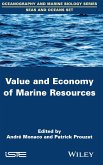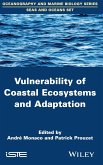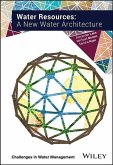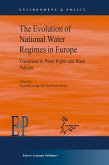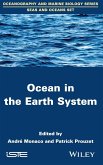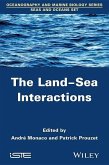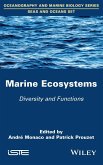- Gebundenes Buch
- Merkliste
- Auf die Merkliste
- Bewerten Bewerten
- Teilen
- Produkt teilen
- Produkterinnerung
- Produkterinnerung
"From the Seas and Oceans Set coordinated by Andrae Mariotti and Jean-Charles Pomerol."
Andere Kunden interessierten sich auch für
![Value and Economy of Marine Resources Value and Economy of Marine Resources]() Value and Economy of Marine Resources169,99 €
Value and Economy of Marine Resources169,99 €![Vulnerability of Coastal Ecosystems and Adaptation Vulnerability of Coastal Ecosystems and Adaptation]() Vulnerability of Coastal Ecosystems and Adaptation169,99 €
Vulnerability of Coastal Ecosystems and Adaptation169,99 €![Water Resources Water Resources]() Alexander LaneWater Resources134,99 €
Alexander LaneWater Resources134,99 €![The Evolution of National Water Regimes in Europe The Evolution of National Water Regimes in Europe]() Stefan Kuks / Ingrid Kissling-Näf (eds.)The Evolution of National Water Regimes in Europe310,99 €
Stefan Kuks / Ingrid Kissling-Näf (eds.)The Evolution of National Water Regimes in Europe310,99 €![Ocean in the Earth System Ocean in the Earth System]() Patrick ProuzetOcean in the Earth System170,99 €
Patrick ProuzetOcean in the Earth System170,99 €![The Land-Sea Interactions The Land-Sea Interactions]() The Land-Sea Interactions170,99 €
The Land-Sea Interactions170,99 €![Marine Ecosystems Marine Ecosystems]() Marine Ecosystems170,99 €
Marine Ecosystems170,99 €-
-
-
"From the Seas and Oceans Set coordinated by Andrae Mariotti and Jean-Charles Pomerol."
Produktdetails
- Produktdetails
- Verlag: Wiley
- Seitenzahl: 236
- Erscheinungstermin: 1. Januar 2015
- Englisch
- Abmessung: 240mm x 161mm x 17mm
- Gewicht: 525g
- ISBN-13: 9781848217058
- ISBN-10: 1848217056
- Artikelnr.: 41244391
- Herstellerkennzeichnung
- Libri GmbH
- Europaallee 1
- 36244 Bad Hersfeld
- gpsr@libri.de
- Verlag: Wiley
- Seitenzahl: 236
- Erscheinungstermin: 1. Januar 2015
- Englisch
- Abmessung: 240mm x 161mm x 17mm
- Gewicht: 525g
- ISBN-13: 9781848217058
- ISBN-10: 1848217056
- Artikelnr.: 41244391
- Herstellerkennzeichnung
- Libri GmbH
- Europaallee 1
- 36244 Bad Hersfeld
- gpsr@libri.de
André Monaco is Emeritus Director of Research for the French national research center (CNRS). His research interests concern marine sedimentology and geochemistry. He was responsible for part of the organizing committee for several French and European programs and has been guest editor for four special issues in international journals. Patrick Prouzet is Director of Research focusing on the ecosystemic approach at Ifremer in France. He specializes in the biology and dynamics of anadromous fish such as Atlantic salmon and eels. He is the author or co-author of several works on these species or on estuary fishing.
FOREWORD ix
CHAPTER 1. FISHING IN THE MEDITERRANEAN, PAST AND PRESENT: HISTORY AND
TECHNICAL CHANGES 1
Daniel FAGET and Jacques SACCHI
1.1. Mediterranean fishing of the past (18th Century) 2
1.1.1. Brotherhoods and prud'homies: old forms of regulation of the fishing
world 2
1.1.2. Plural communities 4
1.1.3. Diversity of traditional techniques in the Mediterranean 6
1.1.4. Speculative fishing: the madrague 10
1.1.5. A highly varied consumption, reflective of relative shortages 11
1.2. Evolving practices (18-19th Centuries) 12
1.2.1. The evolving world of fishing: human migration and technical changes
13
1.2.2. Between the thought of decline and fragility of the environment 15
1.2.3. Aquaculture, or the dream of a domesticated sea (1850-1900) 19
1.2.4. Rationalizing the fishing industry in the Mediterranean: the rise of
"applied zoology" (1880-1914) 20
1.3. Industrial power at the service of fisheries (end of 19th-20th
Century) 22
1.3.1. The industrialization of Mediterranean fishing 24
1.3.2. Seine fishing 25
1.3.3. Trawl fishing 31
1.4. Fishermen today in the Mediterranean 36
1.4.1. The role of fishing in the consumption of sea products 38
1.4.2. Diagnosis, fragility and over-exploitation 40
1.4.3. State of the resource and the environment 42
1.4.4. Ecosystem approach of fisheries and governance 43
1.4.5. Institutions 45
1.4.6. Seeking to promote the value of seas 46
1.4.7. Education, raising awareness and labeling: the fishermen, agents of
a sustainable exploitation of
the environment 48
1.4.8. The necessary consideration of the patrimonial dimension of
artisanal fishing 49
1.5. Bibliography 50
CHAPTER 2. MICROALGAE AND BIOTECHNOLOGY 57
Jean-Paul CADORET, Gaël BOUGARAN, Jean-Baptiste BÉRARD, Grégory CARRIER,
Aurélie CHARRIER, Noémie COULOMBIER, Matthieu GARNIER, Raymond KAAS, Loïc
LE DÉAN, Ewa LUKOMSKA, Elodie NICOLAU, Catherine ROUXEL, Bruno SAINT-JEAN
and Nathalie SCHREIBER
2.1. Microalgae 57
2.2. The potential value of microalgae 59
2.2.1. Human nutrition 59
2.2.2. Animal nutrition 60
2.2.3. Health 61
2.2.4. Cosmetics 65
2.2.5. Industrial application 65
2.2.6. Microalgae as fuel sources 68
2.3. The culture of microalgae 70
2.3.1. Ecophysiological needs 71
2.3.2. Productions and productivities 85
2.4. Research in support of the development of the branch 94
2.4.1. Omics 94
2.4.2. Species improvement 97
2.5. Conclusion 100
2.6. Bibliography 102
CHAPTER 3. PHARMACOLOGY OF REEF MARINE ORGANISMS 117
Cécile DEBITUS and Jean GUÉZENNEC
3.1. Introduction 117
3.1.1. Geographical strengths 117
3.1.2. The marine environment: a source of new molecules 119
3.2. Applications of marine molecules: reality 124
3.2.1. Acquired results 124
3.2.2. Current trends 127
3.3. Concrete examples of marine natural products research programs 129
3.3.1. Steps of a project 130
3.4. Marine environment and biotechnology: the essential role of
microorganisms 135
3.4.1. Microorganisms of the marine environment 136
3.4.2. Example of an atypical ecosystem: microbial mats, or kopara 139
3.5. Bibliography 152
CHAPTER 4. MARINE RENEWABLE ENERGIES 157
Michel PAILLARD, Bernard MULTON and Marc BOEUF
4.1. Introduction 157
4.2. The energetic context and the stakes in the development of renewable
energies 158
4.2.1. Energy resources, reserves and final energy, definitions and
concepts 158
4.2.2. Global, European and French contexts: the stakes 163
4.3. The place of marine energies in renewable energies 167
4.3.1. Marine renewable energies (MRE) 167
4.3.2. The specificities of MRE and their place in the energy mix 170
4.3.3. The four stakes of the development of MRE in France 171
4.3.4. Technological diversity 172
4.3.5. Involvement in France, Europe and the world 184
4.3.6. The importance of MRE overseas and the insular context 188
4.4. Technological and non-technological issues 191
4.4.1. Limitations of the marine environment 191
4.4.2. Development of reliable and economically competitive technology 194
4.4.3. The storing of electricity, a lever for large-scale development 194
4.4.4. Controlling environmental and societal impacts 197
4.4.5. Establishing an adapted regulatory context 200
4.5. Socio-economic consequences 201
4.5.1. The industrial stakes 201
4.5.2. Impacts and usage conflicts to control - compensatory measures 206
4.6. Perspectives 206
4.6.1. Development of the different sectors: present, short- and long-term
206
4.6.2. Today in the world, in Europe and in France 207
4.6.3. 2015-2025: from demonstrators to power plants via pilot facilites
208
4.6.4. 2030 and beyond: large-scale development 210
4.7. Bibliography 211
LIST OF AUTHORS 215
INDEX 217
CHAPTER 1. FISHING IN THE MEDITERRANEAN, PAST AND PRESENT: HISTORY AND
TECHNICAL CHANGES 1
Daniel FAGET and Jacques SACCHI
1.1. Mediterranean fishing of the past (18th Century) 2
1.1.1. Brotherhoods and prud'homies: old forms of regulation of the fishing
world 2
1.1.2. Plural communities 4
1.1.3. Diversity of traditional techniques in the Mediterranean 6
1.1.4. Speculative fishing: the madrague 10
1.1.5. A highly varied consumption, reflective of relative shortages 11
1.2. Evolving practices (18-19th Centuries) 12
1.2.1. The evolving world of fishing: human migration and technical changes
13
1.2.2. Between the thought of decline and fragility of the environment 15
1.2.3. Aquaculture, or the dream of a domesticated sea (1850-1900) 19
1.2.4. Rationalizing the fishing industry in the Mediterranean: the rise of
"applied zoology" (1880-1914) 20
1.3. Industrial power at the service of fisheries (end of 19th-20th
Century) 22
1.3.1. The industrialization of Mediterranean fishing 24
1.3.2. Seine fishing 25
1.3.3. Trawl fishing 31
1.4. Fishermen today in the Mediterranean 36
1.4.1. The role of fishing in the consumption of sea products 38
1.4.2. Diagnosis, fragility and over-exploitation 40
1.4.3. State of the resource and the environment 42
1.4.4. Ecosystem approach of fisheries and governance 43
1.4.5. Institutions 45
1.4.6. Seeking to promote the value of seas 46
1.4.7. Education, raising awareness and labeling: the fishermen, agents of
a sustainable exploitation of
the environment 48
1.4.8. The necessary consideration of the patrimonial dimension of
artisanal fishing 49
1.5. Bibliography 50
CHAPTER 2. MICROALGAE AND BIOTECHNOLOGY 57
Jean-Paul CADORET, Gaël BOUGARAN, Jean-Baptiste BÉRARD, Grégory CARRIER,
Aurélie CHARRIER, Noémie COULOMBIER, Matthieu GARNIER, Raymond KAAS, Loïc
LE DÉAN, Ewa LUKOMSKA, Elodie NICOLAU, Catherine ROUXEL, Bruno SAINT-JEAN
and Nathalie SCHREIBER
2.1. Microalgae 57
2.2. The potential value of microalgae 59
2.2.1. Human nutrition 59
2.2.2. Animal nutrition 60
2.2.3. Health 61
2.2.4. Cosmetics 65
2.2.5. Industrial application 65
2.2.6. Microalgae as fuel sources 68
2.3. The culture of microalgae 70
2.3.1. Ecophysiological needs 71
2.3.2. Productions and productivities 85
2.4. Research in support of the development of the branch 94
2.4.1. Omics 94
2.4.2. Species improvement 97
2.5. Conclusion 100
2.6. Bibliography 102
CHAPTER 3. PHARMACOLOGY OF REEF MARINE ORGANISMS 117
Cécile DEBITUS and Jean GUÉZENNEC
3.1. Introduction 117
3.1.1. Geographical strengths 117
3.1.2. The marine environment: a source of new molecules 119
3.2. Applications of marine molecules: reality 124
3.2.1. Acquired results 124
3.2.2. Current trends 127
3.3. Concrete examples of marine natural products research programs 129
3.3.1. Steps of a project 130
3.4. Marine environment and biotechnology: the essential role of
microorganisms 135
3.4.1. Microorganisms of the marine environment 136
3.4.2. Example of an atypical ecosystem: microbial mats, or kopara 139
3.5. Bibliography 152
CHAPTER 4. MARINE RENEWABLE ENERGIES 157
Michel PAILLARD, Bernard MULTON and Marc BOEUF
4.1. Introduction 157
4.2. The energetic context and the stakes in the development of renewable
energies 158
4.2.1. Energy resources, reserves and final energy, definitions and
concepts 158
4.2.2. Global, European and French contexts: the stakes 163
4.3. The place of marine energies in renewable energies 167
4.3.1. Marine renewable energies (MRE) 167
4.3.2. The specificities of MRE and their place in the energy mix 170
4.3.3. The four stakes of the development of MRE in France 171
4.3.4. Technological diversity 172
4.3.5. Involvement in France, Europe and the world 184
4.3.6. The importance of MRE overseas and the insular context 188
4.4. Technological and non-technological issues 191
4.4.1. Limitations of the marine environment 191
4.4.2. Development of reliable and economically competitive technology 194
4.4.3. The storing of electricity, a lever for large-scale development 194
4.4.4. Controlling environmental and societal impacts 197
4.4.5. Establishing an adapted regulatory context 200
4.5. Socio-economic consequences 201
4.5.1. The industrial stakes 201
4.5.2. Impacts and usage conflicts to control - compensatory measures 206
4.6. Perspectives 206
4.6.1. Development of the different sectors: present, short- and long-term
206
4.6.2. Today in the world, in Europe and in France 207
4.6.3. 2015-2025: from demonstrators to power plants via pilot facilites
208
4.6.4. 2030 and beyond: large-scale development 210
4.7. Bibliography 211
LIST OF AUTHORS 215
INDEX 217
FOREWORD ix
CHAPTER 1. FISHING IN THE MEDITERRANEAN, PAST AND PRESENT: HISTORY AND
TECHNICAL CHANGES 1
Daniel FAGET and Jacques SACCHI
1.1. Mediterranean fishing of the past (18th Century) 2
1.1.1. Brotherhoods and prud'homies: old forms of regulation of the fishing
world 2
1.1.2. Plural communities 4
1.1.3. Diversity of traditional techniques in the Mediterranean 6
1.1.4. Speculative fishing: the madrague 10
1.1.5. A highly varied consumption, reflective of relative shortages 11
1.2. Evolving practices (18-19th Centuries) 12
1.2.1. The evolving world of fishing: human migration and technical changes
13
1.2.2. Between the thought of decline and fragility of the environment 15
1.2.3. Aquaculture, or the dream of a domesticated sea (1850-1900) 19
1.2.4. Rationalizing the fishing industry in the Mediterranean: the rise of
"applied zoology" (1880-1914) 20
1.3. Industrial power at the service of fisheries (end of 19th-20th
Century) 22
1.3.1. The industrialization of Mediterranean fishing 24
1.3.2. Seine fishing 25
1.3.3. Trawl fishing 31
1.4. Fishermen today in the Mediterranean 36
1.4.1. The role of fishing in the consumption of sea products 38
1.4.2. Diagnosis, fragility and over-exploitation 40
1.4.3. State of the resource and the environment 42
1.4.4. Ecosystem approach of fisheries and governance 43
1.4.5. Institutions 45
1.4.6. Seeking to promote the value of seas 46
1.4.7. Education, raising awareness and labeling: the fishermen, agents of
a sustainable exploitation of
the environment 48
1.4.8. The necessary consideration of the patrimonial dimension of
artisanal fishing 49
1.5. Bibliography 50
CHAPTER 2. MICROALGAE AND BIOTECHNOLOGY 57
Jean-Paul CADORET, Gaël BOUGARAN, Jean-Baptiste BÉRARD, Grégory CARRIER,
Aurélie CHARRIER, Noémie COULOMBIER, Matthieu GARNIER, Raymond KAAS, Loïc
LE DÉAN, Ewa LUKOMSKA, Elodie NICOLAU, Catherine ROUXEL, Bruno SAINT-JEAN
and Nathalie SCHREIBER
2.1. Microalgae 57
2.2. The potential value of microalgae 59
2.2.1. Human nutrition 59
2.2.2. Animal nutrition 60
2.2.3. Health 61
2.2.4. Cosmetics 65
2.2.5. Industrial application 65
2.2.6. Microalgae as fuel sources 68
2.3. The culture of microalgae 70
2.3.1. Ecophysiological needs 71
2.3.2. Productions and productivities 85
2.4. Research in support of the development of the branch 94
2.4.1. Omics 94
2.4.2. Species improvement 97
2.5. Conclusion 100
2.6. Bibliography 102
CHAPTER 3. PHARMACOLOGY OF REEF MARINE ORGANISMS 117
Cécile DEBITUS and Jean GUÉZENNEC
3.1. Introduction 117
3.1.1. Geographical strengths 117
3.1.2. The marine environment: a source of new molecules 119
3.2. Applications of marine molecules: reality 124
3.2.1. Acquired results 124
3.2.2. Current trends 127
3.3. Concrete examples of marine natural products research programs 129
3.3.1. Steps of a project 130
3.4. Marine environment and biotechnology: the essential role of
microorganisms 135
3.4.1. Microorganisms of the marine environment 136
3.4.2. Example of an atypical ecosystem: microbial mats, or kopara 139
3.5. Bibliography 152
CHAPTER 4. MARINE RENEWABLE ENERGIES 157
Michel PAILLARD, Bernard MULTON and Marc BOEUF
4.1. Introduction 157
4.2. The energetic context and the stakes in the development of renewable
energies 158
4.2.1. Energy resources, reserves and final energy, definitions and
concepts 158
4.2.2. Global, European and French contexts: the stakes 163
4.3. The place of marine energies in renewable energies 167
4.3.1. Marine renewable energies (MRE) 167
4.3.2. The specificities of MRE and their place in the energy mix 170
4.3.3. The four stakes of the development of MRE in France 171
4.3.4. Technological diversity 172
4.3.5. Involvement in France, Europe and the world 184
4.3.6. The importance of MRE overseas and the insular context 188
4.4. Technological and non-technological issues 191
4.4.1. Limitations of the marine environment 191
4.4.2. Development of reliable and economically competitive technology 194
4.4.3. The storing of electricity, a lever for large-scale development 194
4.4.4. Controlling environmental and societal impacts 197
4.4.5. Establishing an adapted regulatory context 200
4.5. Socio-economic consequences 201
4.5.1. The industrial stakes 201
4.5.2. Impacts and usage conflicts to control - compensatory measures 206
4.6. Perspectives 206
4.6.1. Development of the different sectors: present, short- and long-term
206
4.6.2. Today in the world, in Europe and in France 207
4.6.3. 2015-2025: from demonstrators to power plants via pilot facilites
208
4.6.4. 2030 and beyond: large-scale development 210
4.7. Bibliography 211
LIST OF AUTHORS 215
INDEX 217
CHAPTER 1. FISHING IN THE MEDITERRANEAN, PAST AND PRESENT: HISTORY AND
TECHNICAL CHANGES 1
Daniel FAGET and Jacques SACCHI
1.1. Mediterranean fishing of the past (18th Century) 2
1.1.1. Brotherhoods and prud'homies: old forms of regulation of the fishing
world 2
1.1.2. Plural communities 4
1.1.3. Diversity of traditional techniques in the Mediterranean 6
1.1.4. Speculative fishing: the madrague 10
1.1.5. A highly varied consumption, reflective of relative shortages 11
1.2. Evolving practices (18-19th Centuries) 12
1.2.1. The evolving world of fishing: human migration and technical changes
13
1.2.2. Between the thought of decline and fragility of the environment 15
1.2.3. Aquaculture, or the dream of a domesticated sea (1850-1900) 19
1.2.4. Rationalizing the fishing industry in the Mediterranean: the rise of
"applied zoology" (1880-1914) 20
1.3. Industrial power at the service of fisheries (end of 19th-20th
Century) 22
1.3.1. The industrialization of Mediterranean fishing 24
1.3.2. Seine fishing 25
1.3.3. Trawl fishing 31
1.4. Fishermen today in the Mediterranean 36
1.4.1. The role of fishing in the consumption of sea products 38
1.4.2. Diagnosis, fragility and over-exploitation 40
1.4.3. State of the resource and the environment 42
1.4.4. Ecosystem approach of fisheries and governance 43
1.4.5. Institutions 45
1.4.6. Seeking to promote the value of seas 46
1.4.7. Education, raising awareness and labeling: the fishermen, agents of
a sustainable exploitation of
the environment 48
1.4.8. The necessary consideration of the patrimonial dimension of
artisanal fishing 49
1.5. Bibliography 50
CHAPTER 2. MICROALGAE AND BIOTECHNOLOGY 57
Jean-Paul CADORET, Gaël BOUGARAN, Jean-Baptiste BÉRARD, Grégory CARRIER,
Aurélie CHARRIER, Noémie COULOMBIER, Matthieu GARNIER, Raymond KAAS, Loïc
LE DÉAN, Ewa LUKOMSKA, Elodie NICOLAU, Catherine ROUXEL, Bruno SAINT-JEAN
and Nathalie SCHREIBER
2.1. Microalgae 57
2.2. The potential value of microalgae 59
2.2.1. Human nutrition 59
2.2.2. Animal nutrition 60
2.2.3. Health 61
2.2.4. Cosmetics 65
2.2.5. Industrial application 65
2.2.6. Microalgae as fuel sources 68
2.3. The culture of microalgae 70
2.3.1. Ecophysiological needs 71
2.3.2. Productions and productivities 85
2.4. Research in support of the development of the branch 94
2.4.1. Omics 94
2.4.2. Species improvement 97
2.5. Conclusion 100
2.6. Bibliography 102
CHAPTER 3. PHARMACOLOGY OF REEF MARINE ORGANISMS 117
Cécile DEBITUS and Jean GUÉZENNEC
3.1. Introduction 117
3.1.1. Geographical strengths 117
3.1.2. The marine environment: a source of new molecules 119
3.2. Applications of marine molecules: reality 124
3.2.1. Acquired results 124
3.2.2. Current trends 127
3.3. Concrete examples of marine natural products research programs 129
3.3.1. Steps of a project 130
3.4. Marine environment and biotechnology: the essential role of
microorganisms 135
3.4.1. Microorganisms of the marine environment 136
3.4.2. Example of an atypical ecosystem: microbial mats, or kopara 139
3.5. Bibliography 152
CHAPTER 4. MARINE RENEWABLE ENERGIES 157
Michel PAILLARD, Bernard MULTON and Marc BOEUF
4.1. Introduction 157
4.2. The energetic context and the stakes in the development of renewable
energies 158
4.2.1. Energy resources, reserves and final energy, definitions and
concepts 158
4.2.2. Global, European and French contexts: the stakes 163
4.3. The place of marine energies in renewable energies 167
4.3.1. Marine renewable energies (MRE) 167
4.3.2. The specificities of MRE and their place in the energy mix 170
4.3.3. The four stakes of the development of MRE in France 171
4.3.4. Technological diversity 172
4.3.5. Involvement in France, Europe and the world 184
4.3.6. The importance of MRE overseas and the insular context 188
4.4. Technological and non-technological issues 191
4.4.1. Limitations of the marine environment 191
4.4.2. Development of reliable and economically competitive technology 194
4.4.3. The storing of electricity, a lever for large-scale development 194
4.4.4. Controlling environmental and societal impacts 197
4.4.5. Establishing an adapted regulatory context 200
4.5. Socio-economic consequences 201
4.5.1. The industrial stakes 201
4.5.2. Impacts and usage conflicts to control - compensatory measures 206
4.6. Perspectives 206
4.6.1. Development of the different sectors: present, short- and long-term
206
4.6.2. Today in the world, in Europe and in France 207
4.6.3. 2015-2025: from demonstrators to power plants via pilot facilites
208
4.6.4. 2030 and beyond: large-scale development 210
4.7. Bibliography 211
LIST OF AUTHORS 215
INDEX 217


